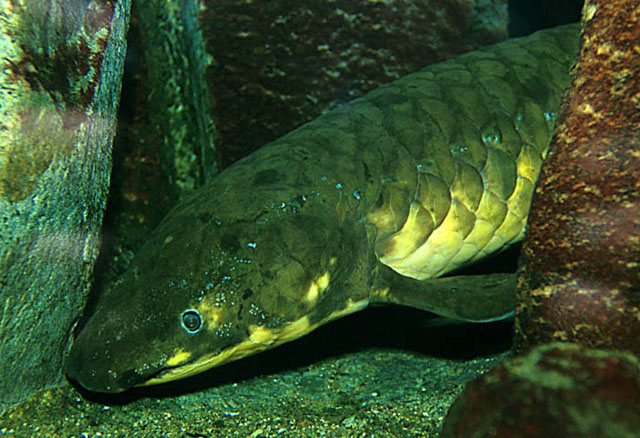| Neoceratodontidae (Australian lungfish) |
| 170 cm TL (male/unsexed); max.weight: 40 kg |
|
demersal; freshwater, potamodromous |
| Oceania: southern Queensland, Australia in Burnett and Mary River systems. Introduced successfully in southeastern Queensland. |
|
Dorsal spines (total): 0-0; Dorsal soft rays (total): 0-0; Anal spines: 0-0; Anal soft rays: 0-0. Body stout and elongate. Dorsal fin originating on the middle of the back, confluent with caudal and anal fins. Body covered with large, bony, overlapping scales. The head is flattened, with conical profile. The eyes are small; the mouth is reaching about half the distance to eye. The pectoral fins are large and flipper-like in ventral position just behind the head; the pelvic fins are also flipper-like, situated far back on the body. |
| Inhabits mud, sand or gravel bottoms (Ref. 44894). Sluggish species that prefers still or slow-flowing waters, usually in deep pools. During period of drought, it can tolerate stagnant conditions by breathing air, surfacing 1-2 times per hour; however, it lacks the ability to survive dry spells by aestivation; it is a facultative air-breather that will die if forced to depend on air breathing (Ref. 36739, 44894). The sound of the lungfish exhaling air at the surface prior to inhaling a fresh breath has been likened to that made by a small bellows. Nocturnally active (Ref. 44894). Feeds on frogs, tadpoles, fishes, shrimp, earthworms, snails, aquatic plants and native fruits fallen from trees overhanging the creeks (Ref. 36739, 44894). It browses among the detritus, using its electroreceptors to pick up hidden mollusks, worms or crustaceans. Protected by law. Fossil records show that this species remained virtually unchanged for over 380 million years. The Steinhart Aquarium in San Francisco had a specimen of 1 m length, 20 kg weight, and more than 65 years of age. In 1933, an Australian lungfish was transported as a fully mature male (10 yrs. old at maturity) to the Shedd Aquarium, Chicago (C. Skonieczny, pers. comm. 11/08, e-mail: CSkonieczny@sheddaquarium.org). But this fish named Granddad, died in 2017 at the age of 95 (Ref 125841). By default, another individual which was brought to the California Academy of Sciences Aquarium in 1938 from Australia becomes the oldest at the age of 90 years. Biologists at the aquarium believe that Methuselah, as it is fondly called, is a female which measures 120 m and weighs 18,100 g (Ref. 125841). |
|
Endangered (EN); Date assessed: 13 February 2019 (B2ab(ii,iii)) Ref. (130435)
|
| harmless |
Source and more info: www.fishbase.org. For personal, classroom, and other internal use only. Not for publication.
